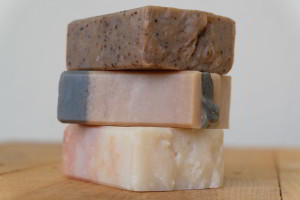There are few methods to make handmade soap, and the most popular method is called Cold Process (CP) as it is easier to prep, control over designs and make bigger batches. As water is mixed with lye and oils to make soap, curing of CP soap is necessary for the water to completely evaporate. The cure time (4-6 weeks) is frustrating if you’re in a hurry to use your soap, but a long cure is necessary to produce a harder bar of soap that will last longer, lather better and just be overall better soap.
One misconception about CP cure time is that the soap is unsafe to use within the 4-6 week time frame because it hasn’t “saponified” yet. Saponification is the chemical reaction between oils, lye and water that produces the substance we call soap! It actually only takes about 24-48 hours for saponification to complete if the ingredients are measured correctly. While the soap does become milder as it ages…but only a TINY TINY bit. This is because 99% of the ph changes happen in the first 48 hours. So technically, you can use your soap after 2 days, but it will be very soft and will most likely fall apart in the shower.
The duration of curing time also depends on the oils used to make the soap. A pure Castile (100% olive oil) soap are usually cured between 6-8 months. Some even cure their soap upto a year! Basically, the more water and soft oils are used, the longer curing time is needed. Now one might say, if we reduce the water, then the curing time will be reduced. This is definitely true and soapmaker calls this method as Water Discount. Water discount would also meant that the lye mixture is VERY VERY concentrated and extreme caution is necessary when doing this. This technique is only meant to be practiced with EXPERIENCED soapmakers and is definitely not for beginners. Another note to remember is that water discount does not eliminate the curing time as water is still part of the ingredients to make soap! Then comes another issue with addicted soapmakers, finding big enough suitable places to cure soaps!


